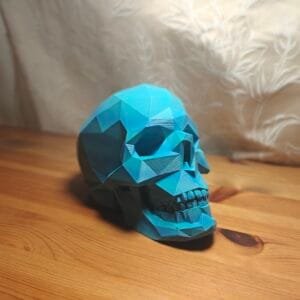Augustus of Prima Porta
€7.50
11h56m-142.87g-15%
(LxWxH)-133x112x159mm
Available on back-order
Attribution to https://makerworld.com/en/models/17760#profileId-16617
One of Augustus Caesar’s most famous portraits is the so-called Augustus of Primaporta of 20 B.C.E. (the sculpture gets its name from the town in Italy where it was found in 1863). At first glance this statue might appear to simply resemble a portrait of Augustus as an orator and general, but this sculpture also communicates a good deal about the emperor’s power and ideology. In fact, in this portrait Augustus shows himself as a great military victor and a staunch supporter of Roman religion. The statue also foretells the 200 year period of peace that Augustus initiated, called the Pax Romana.
In this marble freestanding sculpture, Augustus stands in a contrapposto pose (a relaxed pose where one leg bears weight). The emperor wears military regalia and his right arm is outstretched, demonstrating that the emperor is addressing his troops. We immediately sense the emperor’s power as the leader of the army and a military conqueror.
Delving further into the composition of the Primaporta statue, a distinct resemblance to Polykleitos’ Doryphoros, a Classical Greek sculpture of the fifth century B.C.E., is apparent. Both have a similar contrapposto stance and both are idealized. That is to say that both Augustus and the Spear-Bearer are portrayed as youthful and flawless individuals: they are perfect. The Romans often modeled their art on Greek predecessors. This is significant because Augustus is essentially depicting himself with the perfect body of a Greek athlete: he is youthful and virile, despite the fact that he was middle-aged at the time of the sculpture’s commissioning. Furthermore, by modeling the Primaporta statue on such an iconic Greek sculpture created during the height of Athens’ influence and power, Augustus connects himself to the Golden Age of that previous civilization.
The dolphin became a symbol of Augustus’ great naval victory over Mark Antony and Cleopatra at the Battle of Actium in 31 BCE, a conquest that made Augustus the sole ruler of the Empire. The cupid astride the dolphin sends another message too: that Augustus is descended from the gods. Cupid is the son of Venus, the Roman goddess of love. Julius Caesar, the adoptive father of Augustus, claimed to be descended from Venus and therefore Augustus also shared this connection to the gods.
| Color | Any Colour You Wish! |
|---|
Related products
Home Decor
Home Decor
Home Decor

















